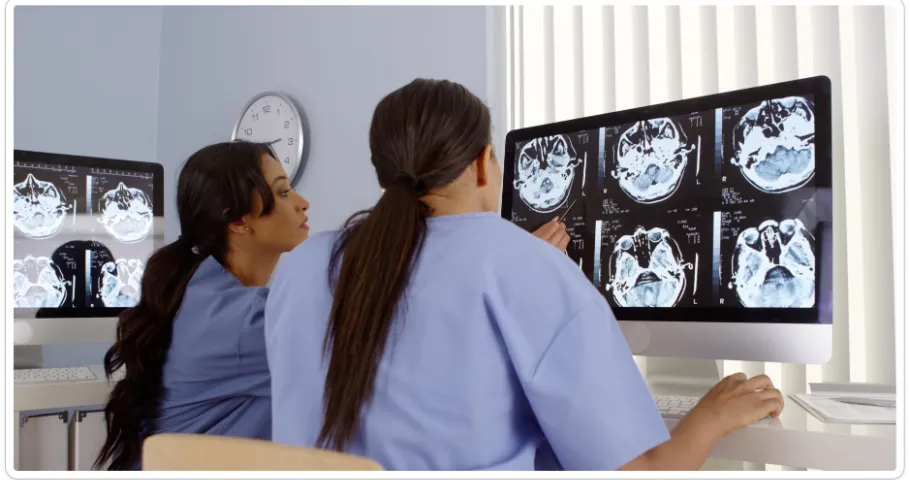- Blog
- Inside radiology’s AI turning point: A conversatio...
Sep 11, 2025 | Read time 4 min
Inside radiology’s AI turning point: A conversation with Robin Barclay
Radiology has long been a test bed for medical technology. Where does voice fit as AI goes mainstream?
Radiology AI is changing the read inside hospitals. Medical Models now triage worklists, size lesions, and assemble first drafts. Ambient voice systems capture findings as they are said. The radiologist remains the final author.
The gains are speed, consistency, and less clerical drag. The bar is accuracy, terminology, and integration.
And here lies the paradox: the more invisible the technology, the greater the responsibility to get it right.
Robin Barclay is a medical specialist at Speechmatics who works at the intersection of voice technology and clinical workflows.
Based near Cambridge, he focuses on deploying speech systems in international healthcare settings and on the integration work that gets tools living inside PACS, RIS, and EHRs.
In this conversation, he outlines what changes now, what stays human, and what it will take for Radiology AI to earn trust.
What is the role of AI in medical imaging and radiology right now?
Three layers. First, AI helps on the imaging modality to create better images; faster with lower dose.
Second. AI handles worklist triage and quantification, for example flagging a likely stroke or measuring a tumor and creating a draft section of a report. Third, voice and ambient tools generate documentation in real time so radiologists can focus on interpretation, not typing.
How is AI being used in radiology reporting day to day?
Let’s start at the worklist. AI pushes suspected urgent studies to the top. During the read, tools pre‑populate fields with measurements and findings. For the write‑up, a model drafts text and flags inconsistencies.
Voice is the backbone throughout. Radiologists dictate, navigate sections by voice, and edit in real time.
That has been true since the move from tapes to digital dictation and then to speech recognition in the 2000s. What is new is how imaging models now inject partial findings into that flow. The clinician then completes the narrative and signs the final report.
What benefits can radiology AI bring to patient care?
AI can triage scans so critical cases are read first, draft reports to save radiologists minutes per study, and standardize terminology so care teams get clearer instructions.
The benefits aren’t just efficient. Patients are being diagnosed faster, waiting less, and receiving treatment plans that are easier to act on.
Is AI accurate enough for radiology workflows?
It depends on the task and dataset. Imaging models can be very strong for specific findings. Reporting assistants improve consistency by catching things like laterality errors.
But credibility lives or dies on language. If a system mishears a core term, trust evaporates. Clinical speech tech has to handle specialist vocabulary and accents inside busy reading rooms.
Is AI coming to take over investigations like radiology in our hospitals?
No. The story is about augmentation. Imaging models can triage cases, take measurements, and draft parts of a report, but it’s the radiologist who interprets, validates, and signs off.
That balance is why adoption has been strong: the tools save time and reduce backlog without altering the clinical standard of care.
Does radiology have scope in the future or does the radiology program get replaced with AI?
Radiology’s scope is only expanding. Scans are bigger, cases are more complex, and most health systems face a shortage of specialists.
Rather than replacing radiologists, AI helps them keep pace by triaging work, drafting reports, and managing workload so expertise is focused where it matters most. That means more patients seen, with no compromise on quality.
Will AI replace radiologists?
Whilst Geoffrey Hinton predicted this in 2016, it is now clear that this is a long way off. But its roles are changing. For radiologists, think of them more as editor in chief rather than sole author.
Imaging outputs are checked, draft text is reviewed, and every clinical document is still signed by a human.
Is radiology at risk without AI?
The risk is falling behind without it. Scan volumes are rising faster than the workforce, and governments often invest in new machines without funding more specialists to read them.
AI tools that prioritize urgent cases and save minutes on every report help departments keep pace and ensure patients are not kept waiting.
What are some promising startups in AI-enhanced radiology?
The interesting work sits in the workflow layer between imaging AI and hospital systems. Incepto and RADpair focus on agile integrations with PACS and RIS so newer models actually live inside the tools clinicians use.
What’s next for voice in radiology?
Voice remains essential. That will not change. The quality bar will.
Accuracy with medical terms is non‑negotiable. Integration has to be painless because the reporting flow now mixes imaging outputs with free dictation.
Custom dictionaries help, but the base model should already understand specialist language.
Price and deployment flexibility matter too, since many departments are rethinking the cost and complexity of legacy speech systems.
👉 Explore Speechmatics Medical Speech Recognition
👉 Discover more about our expansion into Spanish
👉 Read more about Speechmatics' new-gen Medical Model
👉 Compare our Medical Model to other providers
If you’re exploring voice in radiology and want to talk implementation, our team can help. Get in touch here.